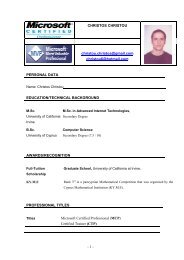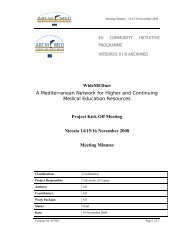Routing Protocols for Ad Hoc Mobile Wireless Networks
Routing Protocols for Ad Hoc Mobile Wireless Networks
Routing Protocols for Ad Hoc Mobile Wireless Networks
Create successful ePaper yourself
Turn your PDF publications into a flip-book with our unique Google optimized e-Paper software.
<strong>Routing</strong> <strong>Protocols</strong> <strong>for</strong> <strong>Ad</strong> <strong>Hoc</strong> <strong>Mobile</strong> <strong>Wireless</strong> <strong>Networks</strong><br />
"member". If the undecided node times out, then it makes itself the cluster-head if it has bi-directional<br />
link to some neighbor otherwise it remains in undecided state and repeats the procedure again.<br />
Clusterheads are changed as infrequently as possible.<br />
Each node maintains a neighbor table. For each neighbor, the neighbor table of a node contains the status<br />
of the link (uni- or bi-directional) and the state of the neighbor (cluster-head or member). A cluster-head<br />
keeps in<strong>for</strong>mation about the members of its cluster and also maintains a cluster adjacency table that<br />
contains in<strong>for</strong>mation about the neighboring clusters. For each neighbor cluster, the table has entry that<br />
contains the gateway through which the cluster can be reached and the cluster-head of the cluster.<br />
When a source has to send data to destination, it floods route request packets (but only to the neighboring<br />
cluster-heads). On receiving the request a cluster-head checks to see if the destination is in its cluster. If<br />
yes, then it sends the request directly to the destination else it sends it to all its adjacent cluster-heads.<br />
The cluster-heads address is recorded in the packet so a cluster-head discards a request packet that it has<br />
already seen. When the destination receives the request packet, it replies back with the route that had<br />
been recorded in the request packet. If the source does not receive a reply within a time period, it backs<br />
off exponentially be<strong>for</strong>e trying to send route request again.<br />
In CBRP, routing is done using source routing. It also uses route shortening that is on receiving a source<br />
route packet, the node tries to find the farthest node in the route that is its neighbor (this could have<br />
happened due to a topology change) and sends the packet to that node thus reducing the route. While<br />
<strong>for</strong>warding the packet if a node detects a broken link it sends back an error message to the source and<br />
then uses local repair mechanism. In local repair mechanism, when a node finds the next hop is<br />
unreachable, it checks to see if the next hop can be reached through any of its neighbor or if hop after<br />
next hop can be reached through any other neighbor. If any of the two works, the packet can be sent out<br />
over the repaired path.<br />
3.2 <strong>Ad</strong> hoc On-demand Distance Vector <strong>Routing</strong><br />
<strong>Ad</strong> hoc On-demand Distance Vector <strong>Routing</strong> (AODV) [Perkins99] is an improvement on the DSDV<br />
algorithm discussed in section 2.1. AODV minimizes the number of broadcasts by creating routes<br />
on-demand as opposed to DSDV that maintains the list of all the routes.<br />
To find a path to the destination, the source broadcasts a route request packet. The neighbors in turn<br />
broadcast the packet to their neighbors till it reaches an intermediate node that has a recent route<br />
in<strong>for</strong>mation about the destination or till it reaches the destination (Figure 4a). A node discards a route<br />
request packet that it has already seen. The route request packet uses sequence numbers to ensure that the<br />
routes are loop free and to make sure that if the intermediate nodes reply to route requests, they reply<br />
with the latest in<strong>for</strong>mation only.<br />
When a node <strong>for</strong>wards a route request packet to its neighbors, it also records in its tables the node from<br />
which the first copy of the request came. This in<strong>for</strong>mation is used to construct the reverse path <strong>for</strong> the<br />
route reply packet. AODV uses only symmetric links because the route reply packet follows the reverse<br />
path of route request packet. As the route reply packet traverses back to the source (Figure 4b), the nodes<br />
along the path enter the <strong>for</strong>ward route into their tables.<br />
If the source moves then it can reinitiate route discovery to the destination. If one of the intermediate<br />
http://www.cis.ohio-state.edu/~jain/cis788-99/adhoc_routing/index.html (9 of 20) [2/7/2000 10:38:34 AM]




